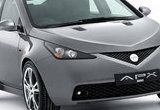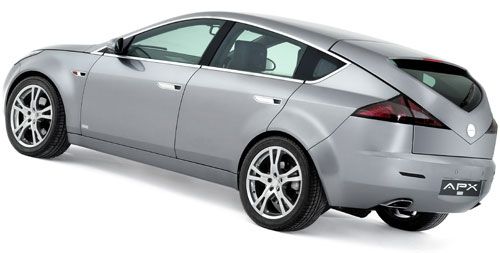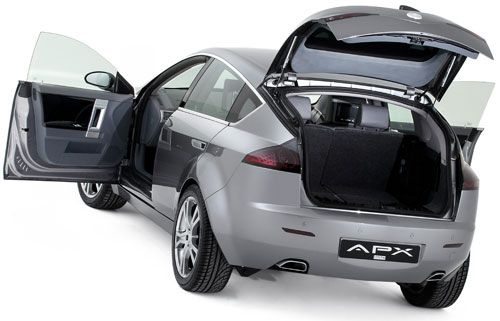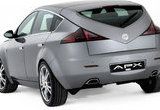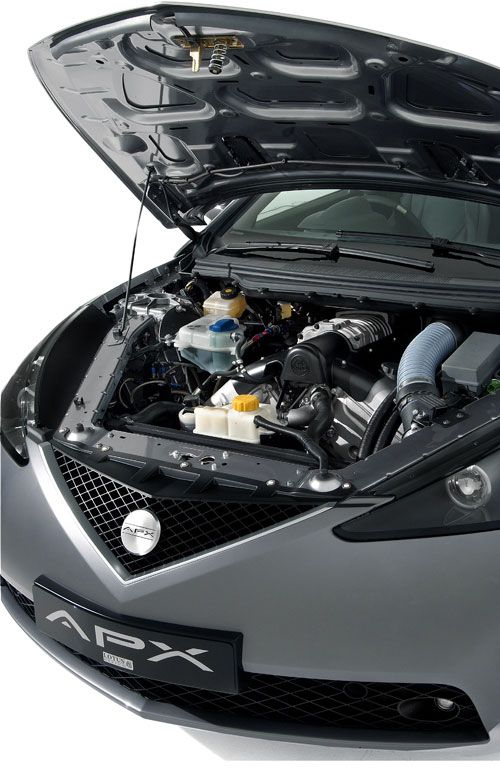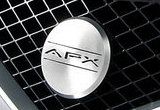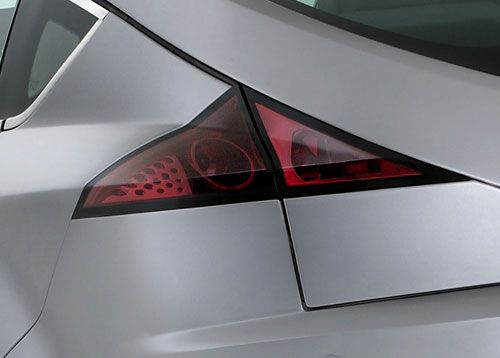APX by Lotus Engineering (APX stands for “Aluminium PerformanceCrossover”) is the first example of a complete vehicle built on the innovativeVersatile Vehicle Architecture (VVA).
APX is a demonstration of Lotus Engineering's ability to create innovative and exciting, highperformance products through its world class capability in Vehicle Design, PerformancePowertrain Engineering and niche vehicle development, the first production car from thistechnology will be the new Lotus mid-engine super sportscar.
2006 Lotus APX
Specifications
- Make: Array
- Model: 2006 Lotus APX
- Engine/Motor: 3.6 liter V6
- Horsepower: 300@6250
- Torque: 4500
It is a 7-seater (in reality a 5 + 2 with the two rear seats being occasional) four-wheel drive “Crossover” vehicle with a front mounted 300 hp supercharged V6 petrol engine. Weighing in at just 1570 kg and with a power to weight ratio of 191 hp per tonne, the APX has sportscar like performance of 5.4 seconds to 100 km/h (5.0 seconds to 60 mph) before reaching a top speed of 245 km/h (152 mph).
These performance figures are as good as the highest performing 4x4 “Crossover” vehicles from other brands with up to 195 hp per tonne. Crucially though, whereas those vehicles need higher output engines to compensate for heavy weight, APX does not. Combined fuel consumption for APX is estimated to be 8.7 litres / 100 km (or 32 mpg) – impressive on its own and more so when compared to its production rivals which often consume more than 13 litres per 100 km (22 mpg).
APX is manufactured predominantly from aluminium in the form of high-pressure die-cast corner nodes, stampings and extrusions. It uses advanced assembly techniques, including adhesive bonding, self-piercing rivets and flow-drill screws for construction – joining techniques that Lotus calls Riv-Bonding. Lotus has optimised the use of these technologies thus significantly reducing the number of mechanical fixings within the monocoque structure. This has reduced the level of investment required in manufacturing equipment.
APX is not just a Lotus Engineering concept, but a feasible prototype close to production; it is not a concept indicating a strategic direction of Lotus Cars; it is, however, a brilliant demonstration of VVA and the skills of the team from Lotus Engineering into what is regarded as the future of niche vehicle manufacture. APX is production feasible as all the components can be made cost effectively and in high niche volume (up to around 30,000 per year).
APX is powered by a V6 engine has been designed by Lotus Engineering’s powertrain division. The directive for Project NEF was to produce a high performance prototype engine without the need to resort to exotic materials or manufacturing technology, allowing manufacture around the world.
APX’s engine is a supercharged 3 litre (2996 cc, Bore: 88 mm, stroke: 82.1 mm) V6 DOHC engine, mounted longitudinally in the front of the vehicle. Performance of the engine is maximum power of 300 hp at 6250 rpm and a torque of 265 lb-st at 4500 rpm.
Like the vehicle, the engine not just a Lotus Engineering concept, but a feasible prototype close to production, however it is not a concept indicating a strategic powertrain direction of Lotus Cars. The engine is production feasible and it is expected that the commercialisation of this engine will be of interest to the automotive clients of Lotus Engineering.
Simon Wood, Director of Lotus Engineering explains the rationale behind building APX: “the first production car from Lotus to use the Versatile Vehicle Architecture will be the new mid engine “super sportscar”, which will go into production in 2008. Lotus Cars customers eagerly await this vehicle that will be a class-leading and phenomenally high performing car. However, we wanted to demonstrate the true versatility of the VVA technology, and what better way than to build a type of car that no one would expect from Lotus – a 4-wheel drive “Crossover” vehicle. I am delighted with this vehicle and we believe that this technology and strategy is what the motor industry must follow to be able to produce niche vehicles efficiently and quickly.
Simon Wood continues; “There is already a great deal of interest in both APX and VVA technology from our client base and we will work hard to see how Lotus Engineering can help them with their strategic product solutions”.
The Engine – 300 hp, 3-litre V6
APX is a front engined and four wheel drive “Crossover” vehicle for occasional off road use. The V6 engine has been designed and developed by Lotus Engineering’s powertrain division. The directive for the project was to produce a high performance prototype engine without the need to resort to exotic materials or manufacturing technology, allowing manufacture around the world. The supercharged V6 is part of a family of normally aspirated and supercharged high performance engines which includes 2.2 litre and 3.0 litre normally aspirated derivatives. All of these engines are at the prototype stage and are production feasible, but are not currently planned for production.
The engine is production feasible and it is expected that the commercialisation of this engine will be of interest to the automotive clients of Lotus Engineering. APX’s engine is a supercharged 3 litre (2996 cc, Bore: 88 mm, stroke: 82.1 mm) V6 DOHC engine, mounted longitudinally in the front of the vehicle. It uses a Rootes-type supercharger with a compact air – to – water Laminova – type charge cooler with separate parallel coolant system using its own water pump and heat exchangers allowing a charge temperature reduction of approximately 50 degrees Celcius.
Performance of the engine is maximum power of 300 hp at 6250 rpm and a torque of 265 lbs-ft at 4500 rpm. 80% of peak torque is between 1500 rpm and maximum revs of 6500 rpm.
Like all products from Lotus, it follows the adage of “performance through light weight”, in that the engine weighs just 171 kg (fully dressed, dry weight). This gives a phenomenal specific output of around 1.31 kW/kg (1.7 hp/kg). Specific performance is 74.6 kW / litre (100 hp / litre, 101.3 PS / litre).
This light weight comes from using cast lightweight aluminium alloy cylinder block (with thin wall iron liners), aluminium cylinder head, and an aluminium structural oilpan, able to support the front drive shafts. The oilpan also includes coolant and lubrication channels to the oil cooler and filter, and an electronic oil level and temperature sensor. Even the pistons are lightweight – with each on weighing just 454 grams!
The construction of the V6 engine is arranged around the two banks of cylinders at an angle of 75 degrees with a compact cylinder offset of just 32.5 mm. This allows the engine to be compact, with good vibration characteristics, eliminating any requirement for balance shafts and the related extra cost, weight, height and complexity.
The Engine Management System uses a state of the art 32 bit ECU processor capable of over 200 million calculations per second. The ECU is Euro IV / E-OBD and LEV/OBDII compliant. And of course the engine satisfies the European End of Life Requirements (ELV) with respect to recyclability and recovery.
The V6 engine is an example of extensive research into “engine downsizing by Lotus Engineering’s Powertrain Team. Engine downsizing is the concept of using advanced technologies to enable a small engine to produce the power and torque of a much larger engine, with the obvious reduction in fuel consumption and emissions. One of the key demands of the automotive industry is to produce engines with not only low emissions and high fuel economy but also extremely good performance. These two demands for performance and economy are not normally compatible unless there is a significant change in the engine development strategy.
Like the vehicle, the engine not just a Lotus Engineering concept, but a feasible prototype close to production, however it is not a concept indicating a strategic powertrain direction of Lotus Cars. The engine is production feasible and it is expected that the commercialisation of this engine will be of interest to the automotive clients of Lotus Engineering.
These performance figures are as good as the highest performing 4x4 “Crossover” vehicles from other brands with up to 195 hp per tonne. Crucially though, whereas those vehicles need higher output engines to compensate for heavy weight, APX does not. Combined fuel consumption for APX is estimated to be 8.7 litres / 100 km (or 32 mpg) – impressive on its own and more so when compared to its production rivals which often consume more than 13 litres per 100 km (22 mpg).
APX is manufactured predominantly from aluminium in the form of high-pressure die-cast corner nodes, stampings and extrusions. It uses advanced assembly techniques, including adhesive bonding, self-piercing rivets and flow-drill screws for construction – joining techniques that Lotus calls Riv-Bonding. Lotus has optimised the use of these technologies thus significantly reducing the number of mechanical fixings within the monocoque structure. This has reduced the level of investment required in manufacturing equipment.
APX is not just a Lotus Engineering concept, but a feasible prototype close to production; it is not a concept indicating a strategic direction of Lotus Cars; it is, however, a brilliant demonstration of VVA and the skills of the team from Lotus Engineering into what is regarded as the future of niche vehicle manufacture. APX is production feasible as all the components can be made cost effectively and in high niche volume (up to around 30,000 per year).
APX is powered by a V6 engine has been designed by Lotus Engineering’s powertrain division. The directive for Project NEF was to produce a high performance prototype engine without the need to resort to exotic materials or manufacturing technology, allowing manufacture around the world.
APX’s engine is a supercharged 3 litre (2996 cc, Bore: 88 mm, stroke: 82.1 mm) V6 DOHC engine, mounted longitudinally in the front of the vehicle. Performance of the engine is maximum power of 300 hp at 6250 rpm and a torque of 265 lb-st at 4500 rpm.
Like the vehicle, the engine not just a Lotus Engineering concept, but a feasible prototype close to production, however it is not a concept indicating a strategic powertrain direction of Lotus Cars. The engine is production feasible and it is expected that the commercialisation of this engine will be of interest to the automotive clients of Lotus Engineering.
Simon Wood, Director of Lotus Engineering explains the rationale behind building APX: “the first production car from Lotus to use the Versatile Vehicle Architecture will be the new mid engine “super sportscar”, which will go into production in 2008. Lotus Cars customers eagerly await this vehicle that will be a class-leading and phenomenally high performing car. However, we wanted to demonstrate the true versatility of the VVA technology, and what better way than to build a type of car that no one would expect from Lotus – a 4-wheel drive “Crossover” vehicle. I am delighted with this vehicle and we believe that this technology and strategy is what the motor industry must follow to be able to produce niche vehicles efficiently and quickly.
Simon Wood continues; “There is already a great deal of interest in both APX and VVA technology from our client base and we will work hard to see how Lotus Engineering can help them with their strategic product solutions”.
The Engine – 300 hp, 3-litre V6
APX is a front engined and four wheel drive “Crossover” vehicle for occasional off road use. The V6 engine has been designed and developed by Lotus Engineering’s powertrain division. The directive for the project was to produce a high performance prototype engine without the need to resort to exotic materials or manufacturing technology, allowing manufacture around the world. The supercharged V6 is part of a family of normally aspirated and supercharged high performance engines which includes 2.2 litre and 3.0 litre normally aspirated derivatives. All of these engines are at the prototype stage and are production feasible, but are not currently planned for production.
The engine is production feasible and it is expected that the commercialisation of this engine will be of interest to the automotive clients of Lotus Engineering. APX’s engine is a supercharged 3 litre (2996 cc, Bore: 88 mm, stroke: 82.1 mm) V6 DOHC engine, mounted longitudinally in the front of the vehicle. It uses a Rootes-type supercharger with a compact air – to – water Laminova – type charge cooler with separate parallel coolant system using its own water pump and heat exchangers allowing a charge temperature reduction of approximately 50 degrees Celcius.
Performance of the engine is maximum power of 300 hp at 6250 rpm and a torque of 265 lbs-ft at 4500 rpm. 80% of peak torque is between 1500 rpm and maximum revs of 6500 rpm.
Like all products from Lotus, it follows the adage of “performance through light weight”, in that the engine weighs just 171 kg (fully dressed, dry weight). This gives a phenomenal specific output of around 1.31 kW/kg (1.7 hp/kg). Specific performance is 74.6 kW / litre (100 hp / litre, 101.3 PS / litre).
This light weight comes from using cast lightweight aluminium alloy cylinder block (with thin wall iron liners), aluminium cylinder head, and an aluminium structural oilpan, able to support the front drive shafts. The oilpan also includes coolant and lubrication channels to the oil cooler and filter, and an electronic oil level and temperature sensor. Even the pistons are lightweight – with each on weighing just 454 grams!
The construction of the V6 engine is arranged around the two banks of cylinders at an angle of 75 degrees with a compact cylinder offset of just 32.5 mm. This allows the engine to be compact, with good vibration characteristics, eliminating any requirement for balance shafts and the related extra cost, weight, height and complexity.
The Engine Management System uses a state of the art 32 bit ECU processor capable of over 200 million calculations per second. The ECU is Euro IV / E-OBD and LEV/OBDII compliant. And of course the engine satisfies the European End of Life Requirements (ELV) with respect to recyclability and recovery.
The V6 engine is an example of extensive research into “engine downsizing by Lotus Engineering’s Powertrain Team. Engine downsizing is the concept of using advanced technologies to enable a small engine to produce the power and torque of a much larger engine, with the obvious reduction in fuel consumption and emissions. One of the key demands of the automotive industry is to produce engines with not only low emissions and high fuel economy but also extremely good performance. These two demands for performance and economy are not normally compatible unless there is a significant change in the engine development strategy.
Like the vehicle, the engine not just a Lotus Engineering concept, but a feasible prototype close to production, however it is not a concept indicating a strategic powertrain direction of Lotus Cars. The engine is production feasible and it is expected that the commercialisation of this engine will be of interest to the automotive clients of Lotus Engineering.

